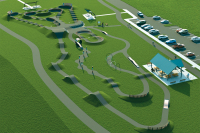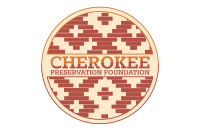Broken bridge ignites debate with Park over North Shore cemeteries
Swain County residents with family buried in cemeteries in the Great Smoky Mountains National Park claim the park service is dragging its feet repairing a washed out bridge used to visit the old graves.
A bridge spanning the mouth of Hazel Creek in the North Shore area of the Park came apart last summer. It will cost upwards of $500,000 to replace it, according to the U.S. Park Service. The Park is requesting federal money to build back the bridge, but it will have to compete against dozens of other national parks for a limited pot of funds.
Dale Ditmanson, superintendent of the Smokies, came to the Swain County commissioners meeting last week, where he got an earful from a few angry Swain County residents who want the bridge repaired immediately.
David Monteith, a county commissioner, said the bridge provided a vital link for those wanting to visit cemeteries where loved ones are still buried in the Park. To reach the cemeteries in the North Shore backcountry, people generally take a ferry across Lake Fontana and walk the rest of the way on old roads, or are driven the remaining distance by park rangers.
In the summer when lake levels are up, the bridge is submerged and the ferry motors up the mouth of Hazel Creek to let people out. But when lake levels drop the rest of the year, the bridge becomes the only way to span the mouth of Hazel Creek. Without the bridge, people have to hike up and around on a narrow trail for more than a mile to reach the same cemeteries.
“Right now, the way it stands between late September and late March, it makes it totally impossible for the handicap and elderly to go up Hazel Creek,” Monteith said. “If you are on a cane, you can’t get there.”
Related Items
Monteith said it also puts a crimp on visitation from hikers, backpackers and fishermen who visit the backcountry.
“That’s major money coming into Swain County,” Monteith said.
Monteith accused Ditmanson of not wanting the bridge built back. Monteith said the Park has inflated what it would actually cost to build the bridge. The higher price tag is going to keep it from being built back, Monteith said.
Monteith consulted the contractor that built the original bridge for an opinion on what it would cost today. The figure he came up with was $100,000 — not $500,000.
Monteith is a leader in the movement to build the North Shore Road, a group that has historically been at odds with the Park.
Monteith offered to write Ditmanson a check for $100,000 if he would go build the bridge back. Ditmanson wouldn’t accept it, which Monteith said shows that the Park doesn’t really want the bridge built back.
“You are trying to block us out,” Monteith said.
Monteith cited what he feels is a pattern of negligence by the Park Service toward the Swain County portion of the Park.
“This is part of us. It feels like they take everything away from Swain County,” Monteith said. “We are losing everything about the Park on this side of the mountain.”
For example, trashcans in the North Shore backcountry have been removed because rangers didn’t want to come empty them.
Monteith said the bridge could have been saved if the Park acted faster. But Park Spokesperson Bob Miller said the Park did not know the integrity of the bridge was compromised until it was too late.
“The first we heard that there was a problem with the bridge is the folks at Fontana Marina called us and said the bridge was floating in the lake,” Miller said.
The Park hired a crew of underwater divers to go in and inspect the submerged bridge and supports. They hoped they could simply tow the wooden bridge back in place and bolt it back, that perhaps the clips attaching the bridge to the beams were all that had rusted out. But it turns out the beams themselves were too corroded, Miller said.
Getting the money
Even if the Park’s request is granted, the money won’t come through until 2011 at the earliest, or 2015 more realistically.
The Park Service is typically working on a five-year time line. So projects that get money today were actually approved five years ago.
Here’s how the process works. Once a year, every park puts together a list of repairs it needs for roads, bridges and facilities. The Department of Interior looks at all the lists and decides which ones get money.
At first, the Park simply turns in a rough estimate of what the work would cost for the Hazel Creek bridge. The Smokies guessed about $500,000. If it makes the government’s short list, then the Park will engage an engineer to do a more sophisticated estimate, Miller said.
“Initially you put in a broad conceptual design and rough estimate,” Miller said. “There is no point to spend money on refining a design until you know that it is even in the pecking order.”
Typically, there’s about $90 million is the pot for road work to be shared under the Department of Interior. The requests that come in are many times that amount, usually a giant laundry list of every project every park would like to see.
“Requesting things you know will never be funded gives the Park Service some idea of how big the road needs are,” Miller said. “If you only request the top three you know will be funded it looks like ‘Oh, you got everything.’”
The pecking order
The Hazel Creek bridge could have a hard time competing for limited national park funds. Technically, it isn’t considered a road used by the public. Rather it’s classified as an “administrative” road used by park personnel only.
“It’s going to be hard for that project to compete very well,” Miller said.
The Smokies saw that disadvantage play out following the floods of 2004, which washed out another bridge in the North Shore area. The Park applied to a pot of emergency money for flood repairs, but was turned down since it was considered “public” use. At the time, Congressman Charles Taylor, R-Brevard, was serving over the subcommittee that controls park service funding and pulled strings to get the repair funded after all. Taylor has since been voted out and replaced with Congressman Heath Shuler, D-Waynesville, who doesn’t have direct sway over the Park budget.
Swain County Manager Kevin King wrote a letter to the Smokies asking for the bridge to be fixed. The letter cites the hardship on the elderly and handicapped trying to visit their family graves.
Miller said he isn’t sure if the local demands, or the issue of cemetery access, will influence the chances for funding.
“It might help to tip the balance or give it a better ranking, but it’s hard to tell,” Miller said.
Miller said the Park is not happy about the bridge washing out either, as it allowed the park rangers better access to the area as well.
But the Hazel Creek bridge replacement isn’t even at the top of the Park’s own list. The list includes items used by far more people or far more urgent, such as restrooms for visitors or saving historic structures in immediate danger of falling down.









